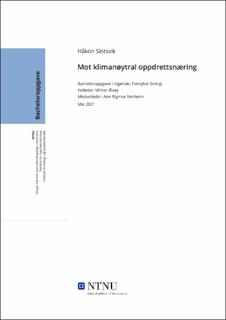| dc.contributor.advisor | Æsøy, Vilmar | |
| dc.contributor.advisor | Nerheim, Ann Rigmor | |
| dc.contributor.author | Slotsvik, Håkon | |
| dc.date.accessioned | 2021-09-21T16:01:18Z | |
| dc.date.available | 2021-09-21T16:01:18Z | |
| dc.date.issued | 2021 | |
| dc.identifier | no.ntnu:inspera:81240705:83775166 | |
| dc.identifier.uri | https://hdl.handle.net/11250/2779948 | |
| dc.description.abstract | Jordkloden er under konstant press ved at vi mennesker slipper ut både gasser og kjemikalier til miljøet. Dette danner grunnlaget for å redusere utslippet av klimagasser til atmosfæren. Hensikten med min oppgave er å få bedre kunnskap rundt de alternative drivstoffene samt de ulike teknologiene for å nyttiggjøre dem til maritim næring.
Min problemstilling: Hvilket drivstoff vil være det mest gunstige om en skal bygge et nytt fartøy for oppdrettsnæringen?. Jeg benyttet følgende forskningspørsmål for å utdype min problemstilling: Hvordan påvirker driftsprofilen til ulike fartøy energiforbruket? Vil størrelsen på fartøyet og operasjonsområdet påvirke hvilket drivstoff og motorteknologi en kan benytte?
Den metodiske tilnærmingen til datainnsamlingen for oppgaven er gjort kvalitativt, mens en i datahåndtering rundt resultater er gjort kvantitativt. Med bakgrunn i oppgavens omfang, er det valgt å presentere resultatene på kvantitativ metode siden omfanget er stort og resultatene er laget for å synliggjøre forskjeller blant drivstoffene.
I den teoretiske innrammingen er det valgt å ta utgangspunkt i tilgjengelig informasjon fra litteratur og internett. Hovedsaklig er dette informasjon som har omhandlet den maritime næringen. Begrensningene for informasjonsinnhenting er gjort til å omhandle maritime klimamål, drivstoff alternativer og energiomformings-teknologi. Det er også gjort begrensinger på hvilke typer fartøyer som oppgaven omhandler, dette er brønnbåter og servicebåter.
Kort oppsummert viser mine hovedfunn at brønnbåtene vil ha størst fordel ved å benytte seg av LNG i form av dualfuel-teknologi frem til avgiftene for CO2-utslipp økes så mye at karbonnøytrale alternativer som ammoniakk vil gjøre seg økonomisk konkurransedyktig. Mindre fartøyer, slik som servicebåten vil ha mindre behov for energi og har ofte landligge i samme havn. Dette gjør at helelektriske servicebåter vil være konkurransedyktig, om en kan lade etter hver arbeidsdag. Her kan også LNG være et godt alternativ i bruk på en dualfuel-motor, gitt at servicefartøyet har tilstrekkelig volum til å installere de sylindriske tankene som vil kreves til dette formålet. | |
| dc.description.abstract | Mother Earth is put under constant pressure by us humans releasing both climate gases and chemicals into the environment. This forms the basis for reducing greenhouse gas emissions into the atmosphere. The purpose of my thesis is to gain better knowledge regarding the alternative fuels as well as the various technologies to utilize them for the maritime industry.
My problem to solve: Which fuel will be the most favorable if building a new vessel for the aquaculture industry?
I used the following research questions to elaborate my problem: How does the operating profile of different vessels affect energy consumption? Will the size of the vessel and operational area affect the alternative fuel and engine technology usage?
The methodological approach to data collection for the thesis is done qualitatively, while data management regarding results is done quantitatively. Based on the scope of the thesis, it has been chosen to present the results in a quantitative method since the scope is large and the results are designed to make visible differences among the fuels.
The theoretical framework are based on available information from literature and the internet. This is mainly information that reviews the maritime industry. Information gathering are restricted to contain mostly maritime climate goals, fuel alternatives and energy conversion technology. Restrictions have also been made on which type of vessel the thesis deals with, these vessels are fish carrier and service vessel.
In short, my main result of my study show that the fish carrier will have the largest advantage by using LNG as fuel in dualfuel technology. This will be the situation at least until the taxes for CO2 emissions has increased to a level that carbon neutral alternatives such as ammonia will become economically competitive. Smaller vessels such as the service vessel has a lower energy need and are often located in the same port. This means that options such as full electric service vessels will be competitive in some cases, if the service vessel can charge its batteries after each working day. For these types of vessels, LNG will also be a good alternative used in dualfuel engine, given that the service vessel has sufficient space to install the cylindrical tanks needed for this purpose. | |
| dc.language | nob | |
| dc.publisher | NTNU | |
| dc.title | Mot klimanøytal oppdrettsnæring | |
| dc.type | Bachelor thesis | |
